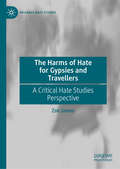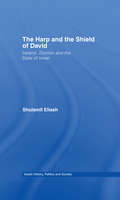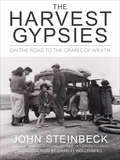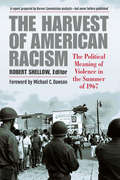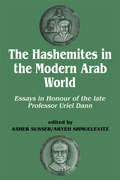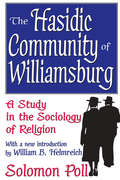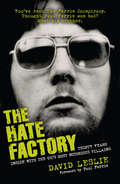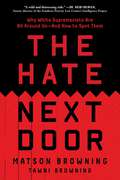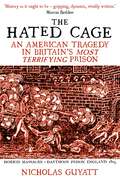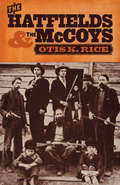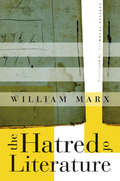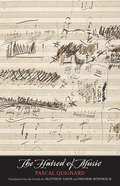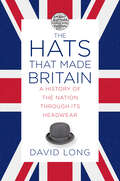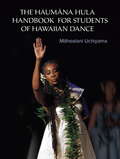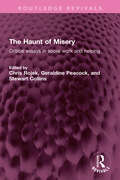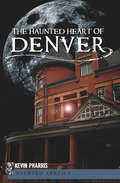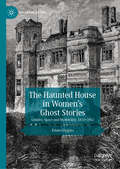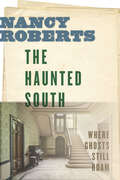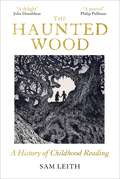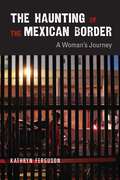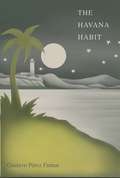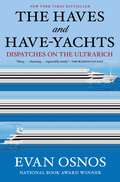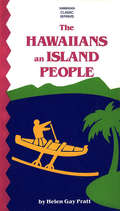- Table View
- List View
The Harms of Hate for Gypsies and Travellers: A Critical Hate Studies Perspective (Palgrave Hate Studies)
by Zoë JamesGypsies and Travellers have often been overlooked as victims of hate crime and discrimination. This book redresses that exclusion by shining a light on the harms of hate experienced by Gypsies and Travellers in the UK. In doing so James explores how hate permeates all aspects of their lives and identifies the hate crimes, incidents, and speech that they are subject to. It goes on to explore how hate against Gypsies and Travellers occurs as discrimination, social exclusion and criminalisation and how that hate is embedded within the language and practice of neoliberal capitalism. This book provides new insights to critical criminology and ways of understanding hate by using the critical hate studies perspective to gain a full appreciation of the harms of hate. As a consequence of this, the book is able to do justice to Gypsies' and Travellers' experiences of hate by extrapolating how harms manifest and the impact they have on Gypsies’ and Travellers’ social and personal identities. The book explains and acknowledges how hate harms imbue Gypsies' and Travellers' daily lives, including common events of serious abuse and assault, regular ill-treatment in provision of services, and everyday micro-aggressions. It argues hate experienced by Gypsies and Travellers can only be fully recognised through an analysis of the neoliberal capitalist context within which it occurs and the harmful subjective experience it engenders. The author’s expertise in this area, having carried out research with Gypsies and Travellers for 25 years, underpins the book with excellent empirical knowledge and research-informed discussion.
The Harp and the Shield of David: Ireland, Zionism and the State of Israel (Israeli History, Politics and Society)
by Shulamit EliashEliash examines the relationship between Ireland and the Zionist movement, and the state of Israel from the context of Palestine’s partition and the delay in Ireland’s recognition of the State of Israel until 1963. Analyzing the Irish attitude to the partition of Palestine through an analogy with that of Ireland, this engaging text compares both the Irish and Zionist views on the partition plans of 1937 and 1947. The study underscores the contrast between Ireland’s separatist policy and its sparse diplomatic connections on the one hand, and Israel’s global diplomacy on the other, and discusses how this gap contributed to Ireland’s delay in recognizing the State of Israel. Shedding light on Irish and Israeli foreign policy, the book also calls into question the ability of small states to form independent foreign policy, the Vatican’s influence on devout Catholic states like Ireland, and the role of Irish and Jewish diasporas in the US.
The Haruki Phenomenon: Haruki Murakami as Cosmopolitan Writer
by Tomoki WakatsukiThis book explores the idea of a new cosmopolitan Japanese identity through a socio-cultural analysis of contemporary Japanese writer Haruki Murakami. It is the first monograph to apply the idea of cosmopolitanism to this writer’s global popularity widely known as the “Haruki phenomenon”.By pioneering an enquiry into Murakami’s cosmopolitanism, this book aims to overcome the prevailing myth of “Japaneseness”(Nihonjinron) as a form of self-identification for Japanese, and propose an alternative approach for contemplating contemporary Japanese cultural identity. Socio-cultural analysis of this author and his works shall establish Murakami’s cosmopolitan qualities and how they contribute to the cultural phenomenon of globalization. Furthermore, this book will introduce the idea of “everyday cosmopolitanism” as a relevant concept to address an emergent global cultural sphere. Unlike the traditional model of cosmopolitanism, which is sometimes regarded as idealist and elitist, “everyday cosmopolitanism” encompasses the everyday spheres of ordinary people. Tomoki Wakatsuki argues that the Haruki phenomenon, as a global and local event, echoes this important social trend today. Murakami’s departure from conventional notions of Japanese identity offers an alternative perception of identity and belonging that is useful for situating Japanese identity within a global context. This text will be of interest to students and scholars of cultural studies, global literature, contemporary Japanese literature, cultural cosmopolitanism and the global cultural sphere.
The Harvest Gypsies: On the Road to the Grapes of Wrath (Library Of America John Steinbeck Edition Ser. #2)
by John SteinbeckA collection of newspaper articles about Dust Bowl migrants in California&’s Central Valley by the author of The Grapes of Wrath, accompanied by photos. Three years before his triumphant novel The Grapes of Wrath—a fictional portrayal of a Depression-era family fleeing Oklahoma during a disastrous period of drought and dust storms—John Steinbeck wrote seven articles for the San Francisco News about these history-making events and the hundreds of thousands who made their way west to work as farm laborers. With the inquisitiveness of an investigative reporter and the emotional power of a novelist in his prime, Steinbeck toured the squatters&’ camps and Hoovervilles of rural California. The Harvest Gypsies gives us an eyewitness account of the horrendous Dust Bowl migration, and provides the factual foundation for Steinbeck&’s masterpiece. Included are twenty-two photographs by Dorothea Lange and others, many of which accompanied Steinbeck&’s original articles. '&”Steinbeck&’s potent blend of empathy and moral outrage was perfectly matched by the photographs of Dorothea Lange, who had caught the whole saga with her camera—the tents, the jalopies, the bindlestiffs, the pathos and courage of uprooted mothers and children.&”—San Francisco Review of Books &“Steinbeck&’s journalism shares the enduring quality of his famous novel…Certain to engage students of both American literature and labor history.&”—Publishers Weekly
The Harvest of American Racism: The Political Meaning of Violence in the Summer of 1967
by Robert ShellowIn the summer of 1967, in response to violent demonstrations that rocked 164 U.S. cities, the National Advisory Commission on Civil Disorders, a.k.a. the Kerner Commission, was formed. The Commission sought reasons for the disturbances, including the role that law enforcement played. Chief among its research projects was a study of 23 American cities, headed by social psychologist Robert Shellow. An early draft of the scientists’ analysis, titled “The Harvest of American Racism: The Political Meaning of Violence in the Summer of 1967,” provoked the Commission’s staff in November 1967 by uncovering political causes for the unrest; the team of researchers was fired, and the controversial report remained buried at the LBJ Presidential Library until now. ? The first publication of the Harvest report half a century later reveals that many of the issues it describes are still with us, including how cities might more effectively and humanely react to groups and communities in protest. In addition to the complete text of the suppressed Harvest report, the book includes an introduction by Robert Shellow that provides useful historical context; personal recollections from four of the report’s surviving social scientists, Robert Shellow, David Boesel, Gary T. Marx, and David O. Sears; and an appendix outlining the differences between the unpublished Harvest analysis and the well-known Kerner Commission Report that followed it. “The [Harvest of American Racism] report was rejected by Johnson administration functionaries as being far too radical—politically ‘unviable’… Social science can play an extremely positive role in fighting racial and other injustice and inequality, but only if it is matched with a powerful political will to implement the findings. That will has never come from within an American presidential administration—that will has only been forged in black and other radical communities’ movements for justice. The political power for change, as incremental as it has been, has come from within those communities. Washington responds, it does not lead." —from the Foreword by Michael C. Dawson
The Hashemites in the Modern Arab World: Essays in Honour of the late Professor Uriel Dann
by Uriel Dann Aryeh Shmuelevitz Asher SusserExamines the crucial role of the Hashemites in Arab nationalism throughout the 20th century, from the 1916 Arab Revolt through the creation of Arab states after World War I, the attempts at Arab unity, and the establishment of two kingdoms, to the current Palestinian debate.
The Hasidic Community of Williamsburg: A Study in the Sociology of Religion
by Solomon PollThe Hasidim of the Williamsburg section of Brooklyn separate themselves not only from non-Jews and unreligious Jews but also from religious Orthodox Jews whose religious ideology, intensity, and frequency of traditional religious behavior do not meet Hasidic standards. These Hasidim create a sociological wall between themselves and other Jews whom they do not consider traditionally religious. This being the case, how is it the Hasidim are able to survive, indeed thrive, well into the twenty-first century while maintaining their social isolation and avoiding assimilation into the American culture, especially living amongst the cultural and ethnic diversity and temptations of New York City? The Hasidic Community of Williamsburg explores and explains this sociological phenomenon.Poll explains some main tenets on the which the Hasidim of Williamsburg have come to rely: making secular activities sacred; incorporating modern devices into their lives to promote and advance their own religious observance; separating themselves, using daily activities including the clothes they wear, the food they eat, the places they gather, and even the language they speak among themselves; and by incorporating American values into their lives while simultaneously casting aspersions on and demonizing all those who do not follow their exact way of life.Until now the Hasidim have successfully achieved social isolation while also continuing to thrive as a group. They have created a well-functioning community with social controls and little or no deviation. However, as the outside society continues to advance and the Hasidim, themselves, further incorporate the very American ideals of hard work, economic success, progress, prosperity, and profit into their own community value system, will their social controls remain effective or become weakened?
The Hate Factory: Thirty Years Inside with the UK's Most Notorious Villains
by David LeslieConvicted murderer Billy Ferris has endured more than three decades behind bars in many of Britain's prisons. In The Hate Factory, he candidly documents his experiences in jail with some of the UK's most notorious criminals.Jailed for life in 1977 for a crime of passion, Ferris experienced betrayal and treachery on the inside. He unexpectedly formed friendships that led to his being labelled a 'bombers' crony' and found love while on the run after a dramatic escape. He vividly describes the cruelty, savagery and degradation that go hand in hand with prison life and details the nightmare that was Wormwood Scrubs, the prison he christened 'the Hate Factory'. He relays what happened when his cell was used as a courtroom for an IRA punishment trial and how he hatched a plan to assassinate the son of a legendary underworld godfather and plotted to murder an informer.Over the 30 years during which Ferris has been imprisoned, his fellow inmates have included some of the UK's 'most wanted' from London underworld enforcer 'Mad' Frankie Fraser to Archie Hall, the serial killer dubbed 'the Monster Butler'.
The Hate Next Door: Undercover within the New Face of White Supremacy
by Matson BrowningThe changing face of hate is on your doorstep…Matt Browning, an undercover detective in Arizona, thought he knew what hate looked like; that is, until he got a front row seat to White supremacy. What followed was a career of hardship and danger, and what he uncovered can no longer go left untold.For more than twenty-five years, Browning has been infiltrating, documenting, and disrupting white supremacy movements from the inside, gaining an intimate vantage point to the KKK, skinheads, border militias, Proud Boys, and other White Power groups, as they organized and grew, their ranks alarmingly including police force and military veterans. Together with his intrepid wife, Tawni, he adopted fake IDs and ideologies, seeking the arrest of its participants—none more so than J.T. Ready, a neo-Nazi who took "hunting trips" for border migrants while gaining mainstream acceptance as a political candidate—and terrorizing Browning's family. What others dismissed as fringe groups, Browning quickly recognized as large and interconnecting organizations permeating into every facet of American society, effectively spreading their dangerous and repugnant rhetoric at unprecedented speeds. Today, after the violent storming of the Capitol on January 6th, the threat posed by these toxic organizations can no longer be ignored by the public at large.In this imperative and gripping narrative, Browning gives readers the inside story of modern-day White supremacy in America in all of its ugly variation. Following his dramatic, high-stakes attempts to take down powerful White supremacists, the torment he faced whilst working undercover, and his eventual creation of the international Skinhead Intelligence Network, The Hate Next Door is a riveting, enlightening, and essential look at the what, where, when, and why of white supremacist groups, how to identify them, and why we must all do everything in our power to fight against them.
The Hated Cage: An American Tragedy in Britain's Most Terrifying Prison
by Nicholas Guyatt&‘Beguiling&’ The Times &‘This is history as it ought to be – gripping, dynamic, vividly written&’ Marcus Rediker The War of 1812 – the last time Britain and America went to war with each other. British redcoats torch the White House and six thousand American sailors languish in the world&’s largest prisoner-of-war camp, Dartmoor. A myriad of races and backgrounds, with some prisoners as young as thirteen. Known as the &‘hated cage&’, Dartmoor wasn&’t a place you&’d expect to be full of life and invention. Yet prisoners taught each other foreign languages and science, put on plays and staged boxing matches. In daring efforts to escape they lived every prison-break cliché – how to hide the tunnel entrances, what to do with the earth… Drawing on meticulous research, The Hated Cage documents the extraordinary communities these men built within the prison – and the terrible massacre that destroyed these worlds.
The Hatfields & the McCoys
by Otis K. Rice&“A captivating account of two families whose stubbornness and loyalty were exceeded only by their capacity for a terrible revenge.&” —Southern Living The Hatfield-McCoy feud has long been a famous part of Appalachian history, but over the years it&’s become encrusted with myth and error. Novelists, motion picture producers, television writers, and others have neglected to separate fact from fiction, and sensationalized events that needed no embellishment. Using court records, public documents, official correspondence, and other sources, Otis K. Rice presents an account that frees, as much as possible, truth from legend. He weighs the evidence carefully, avoiding the partisanship and the attitude of condescension and condemnation that have characterized many of the writings concerning the feud. He also sets the feud in the social, political, economic, and cultural context of eastern Kentucky and southwestern West Virginia in the late nineteenth and early twentieth centuries. By examining the legacy of the Civil War, the weakness of institutions such as the church and education system, the exaggerated importance of family, the impotence of the law, and the isolation of the mountain folk, Rice gives new meaning to the origins and progress of the feud. These conditions help explain why the Hatfield and McCoy families, which have produced so many fine citizens, could engage in such a bitter and prolonged vendetta.
The Hatred of Literature
by William MarxFor 2,500 years literature has been condemned in the name of authority, truth, morality and society. But in making explicit what a society expects from literature, anti-literary discourse paradoxically asserts the validity of what it wishes to deny. The threat to literature’s continued existence, William Marx writes, is not hatred but indifference.
The Hatred of Music
by Pascal Quignard Matthew Amos Fredrik RönnbäckThroughout Pascal Quignard's distinguished literary career, music has been a recurring obsession. As a musician he organized the International Festival of Baroque Opera and Theatre at Versailles in the early 1990s, and thus was instrumental in the rediscovery of much forgotten classical music. Yet in 1994 he abruptly renounced all musical activities. The Hatred of Music is Quignard's masterful exploration of the power of music and what history reveals about the dangers it poses. From prehistoric chants to challenging contemporary compositions, Quignard reflects on music of all kinds and eras. He draws on vast cultural knowledge--the Bible, Greek mythology, early modern history, modern philosophy, the Holocaust, and more--to develop ten accessible treatises on music. In each of these small masterpieces the author exposes music's potential to manipulate, to mesmerize, to domesticate. Especially disturbing is his scrutiny of the role music played in the concentration camps of Nazi Germany. Quignard's provocative book takes on particular relevance today, as we find ourselves surrounded by music as never before in history.
The Hats that Made Britain: A History of the Nation Through its Headwear
by David LongMany of the world’s most famous hats have their origins in Britain; in the Middle Ages there were civil and religious laws requiring hats to be worn and in Victorian Britain a person would no more leave home without a hat than a pair of trousers. It is no surprise that London’s oldest surviving shop, Lock and Co., is a hatter. From practical everyday caps and bonnets to military headwear, top hats, and even the coronation crown, hats of all sorts have passed through its doors and continue to do so after more than 300 years. In this fascinating new book David Long reveals how much of Britain’s social history can be understood through its headwear, and in exploring the ways in which a hat speaks volumes about its wearer’s rank and status he tells the stories of the people beneath some of the most famous hats of history.
The Hatseller and the Monkeys
by Baba Wague DiakiteBaMusa the hatseller traveled from town to town with his hats piled high on his head. "Hee Manum nin koi kadi sa!" he sang, which means, "What a wonderful busineness hat selling is!" One day, BaMusa set out for a festival that was a day's walk away. He was in such a hurry to leave, he didn't eat any breakfast. Halfway there, he grew so tired and hungry, he had to stop and rest. But when he woke up, his hats were gone! Soon he discovered the monkeys high in the tree branches above him were all wearing colorful hats! How would he get them back? It wasn't until BaMusa put some food in his stomach that he could think clearly and figure out exactly what he must do.--From book jacket
The Haumana Hula Handbook for Students of Hawaiian Dance: A Manual for the Student of Hawaiian Dance
by Mahealani Uchiyama Naomi Leina'Ala KalamaA great resource for students of traditional Hawaiian dance, this beautiful handbook filled with archival photographs covers the origins, language, etiquette, ceremonies, and the spiritual culture of Hula. Hula, the indigenous dance of Hawai'i, preserves significant aspects of Native Hawaiian culture with strong ties to health and spirituality. Kumu Hula, persons who are culturally recognized Hula experts and educators, maintain and share this cultural tradition, conveying Hawaiian history and spiritual beliefs in this unique form of cultural and creative expression, comprising specific controlled rhythmic movements that enhance the meaning and poetry of the accompanying songs.Emphasizing the importance of cultural literacy, the Handbook begins with an overview of the origins of Hula, its history in Hawai'i, and the primacy of the spiritual focus of the dance. The book goes on to introduce halau etiquette and practices, and explains the format of a traditional Hula presentation, together with the genres of Hula and the regalia worn by the dancers. Practical components include sections on Hawaiian language and chant and a glossary of Hula commands and footwork.Author Mahealani Uchiyama trained in Hawaii in the Hula lineage of Joseph Kamoha'i Kaha'ulelio and is currently the Kumu Hula at the Halau Ku Ua Tuahine in Berkeley, California. As the founder and artistic director of the Center for International Dance and board member of Dance Arts West, the producers of San Francisco's annual Ethnic Dance Festival, Uchiyama's approach to Hula is deeply holistic and reflects her background in indigenous wisdom traditions and cultural exchange and interaction.From the Trade Paperback edition.
The Haunt of Misery: Critical essays in social work and helping (Routledge Revivals)
by Chris Rojek Stewart Collins Geraldine PeacockFirst published in 1989, The Haunt of Misery offers social workers and students critical essays for critical times. Faced with unreflective wealth creation and the fragmentation of the counterculture, social work is perceived as failing to meet the needs of the client. Many social workers are left feeling angry, stranded and confused. Written by academics and professionals, the essays range over social work and unemployment, the crisis of AIDS and HIV infection, drug use, client collectives, the elderly, the ethnic minorities, professionalism, and self-management. The authors offer constructive criticism of existing social work practice and suggest radical and exciting issues for the profession in the 1990s and beyond.
The Haunted Heart of Denver (Haunted America)
by Kevin PharrisThere is no shortage of ghouls and goblins in Colorado&’s Mile High City. Just ask reluctant ghost hunter Kevin Pharris, author of Riding Denver&’s Rails. The Gates of Hell are rumored to lie below a hotel near Denver&’s capitol building, and there are tales of restless spirits of those buried in Cheesman Park. Above the subterranean darkness, the city streets are haunted by the murderous poltergeist of the Capitol Hill Thug. Even the stately mansions of Millionaires&’ Row hide their own secrets, a sad Victorian lady begs for help before vanishing in the Sheedy Mansion, and an eerie face appears on the façade of the Cresswell House. Join tour guide and reluctant ghost hunter Kevin Pharris as he takes a chilling journey through The Haunted Heart of Denver. Includes photos!
The Haunted House in Women’s Ghost Stories: Gender, Space and Modernity, 1850–1945 (Palgrave Gothic)
by Emma LigginsThis book explores Victorian and modernist haunted houses in female-authored ghost stories as representations of the architectural uncanny. It reconsiders the gendering of the supernatural in terms of unease, denial, disorientation, confinement and claustrophobia within domestic space. Drawing on spatial theory by Gaston Bachelard, Henri Lefebvre and Elizabeth Grosz, it analyses the reoccupation and appropriation of space by ghosts, women and servants as a means of addressing the opposition between the past and modernity. The chapters consider a range of haunted spaces, including ancestral mansions, ghostly gardens, suburban villas, Italian churches and houses subject to demolition and ruin. The ghost stories are read in the light of women’s non-fictional writing on architecture, travel, interior design, sacred space, technology, the ideal home and the servant problem. Women writers discussed include Elizabeth Gaskell, Margaret Oliphant, Vernon Lee, Edith Wharton, May Sinclair and Elizabeth Bowen. This book will appeal to students and researchers in the ghost story, Female Gothic and Victorian and modernist women’s writing, as well as general readers with an interest in the supernatural.
The Haunted South: Where Ghosts Still Roam
by Nancy RobertsThe Old South comes to supernatural life in this classic collection of chilling tales from the “custodian of the twilight zone” (Southern Living).Nancy Roberts, known as the “First Lady of American Folklore,” is a topnotch storyteller and one of the few who both write and tell their own stories. For more than two decades, Ms. Roberts has documented ghost stories and interviewed hundreds of people throughout the United States.A nationally known author of twenty-three books, Ms. Roberts began her career with a series of ghost stories written for The Charlotte Observer. Carl Sandburg sent her word that her stories were good, suggesting “they should be a book.” Since then her books have won her a certificate of commendation from the American Association for State and Local History and a nomination for the Great Western Writer’s Spur Award.The Haunted South includes tales about . . . An angel sighting in the North Carolina mountainsA poltergeist occurrence that drew trainloads of spectators to Jessup, GeorgiaA ghostly warning in Atlanta presaging a major plane crashA North Carolina tavern where unsuspecting travelers were murderedAn omen of death brought by South Carolina’s “Gray Lady”The apparition of an Alabama Railroad Robin HoodA ghost ship off North Carolina’s Outer BanksPraise for Nancy Roberts“Ghost hunter/author Nancy Roberts has put together as shivery a selection of other worldly tales as you’re likely to find anywhere . . . And whether you believe in ghosts or not, these tales are guaranteed to give you a chill, especially before you go into a dark room alone.” —Southern Living
The Haunted Wood: A History of Childhood Reading
by Sam Leith*A Sunday Times, Irish Times, Financial Times, Independent, Daily Mail, TLS, Economist, Prospect, Evening Standard and New Statesman Book of the Year 2024* Can you remember the first time you fell in love with a book? The stories we read as children matter. The best ones are indelible in our memories; reaching far beyond our childhoods, they are a window into our deepest hopes, joys and anxieties. They reveal our past – collective and individual, remembered and imagined – and invite us to dream up different futures. In a pioneering history of the children&’s literary canon, The Haunted Wood reveals the magic of childhood reading, from the ancient tales of Aesop, through the Victorian and Edwardian golden age to new classics. Excavating the complex lives of our most beloved writers, Sam Leith offers a humane portrait of a genre and celebrates the power of books to inspire and console entire generations. *** 'A MARVEL' PHILIP PULLMAN 'A DELIGHT' JULIA DONALDSON 'GLORIOUSLY ENTERTAINING' TOM HOLLAND
The Haunting of the Mexican Border: A Woman's Journey
by Kathryn FergusonThe Haunting of the Mexican Border is a woman&’s view of the violence and generosity of the border. For fifteen years beginning in the 1980s, Kathryn Ferguson made documentary films in Mexico&’s Sierra Madre. As she traveled south, she encountered people who were traveling north, and she learned that the border at which they converged was deadly. Drawing on her own experiences, this book explores how US immigration policies erode the lives of ordinary citizens on both sides of the border.
The Havana Habit
by Gustavo Pérez FirmatCuba, an island 750 miles long, with a population of about 11 million, lies less than 100 miles off the U.S. coast. Yet the island's influences on America's cultural imagination are extensive and deeply ingrained. In the engaging and wide-ranging "Havana Habit", writer and scholar Gustavo Perez Firmat probes the importance of Havana, and of greater Cuba, in the cultural history of the United States. Through books, advertisements, travel guides, films, and music, he demonstrates the influence of the island on almost two centuries of American life. From John Quincy Adams' comparison of Cuba to an apple ready to drop into America's lap, to the latest episodes in the lives of the 'comic comandantes and exotic exiles', and to such notable Cuban exports as the rumba and the mambo, cigars and mojitos, the Cuba that emerges from these pages is a locale that Cubans and Americans have jointly imagined and inhabited. The "Havana Habit" deftly illustrates what makes Cuba, as Perez Firmat writes, "so near and yet so foreign".
The Haves and Have-Yachts: Dispatches on the Ultrarich
by Evan OsnosFrom New York Times bestselling and National Book Award–winning author Evan Osnos comes a timely and provocative collection of essays exploring American oligarchy and the culture of excess, providing a wry, unfiltered look at how the ultrarich shape—and sometimes warp—our social and political landscape.The ultrarich hold more of America&’s wealth than they did in the heyday of the Carnegies and Rockefellers. Here, Evan Osnos&’s incisive reportage yields an unforgettable portrait of the tactics and obsessions driving this new Gilded Age, in which superyachts, luxury bunkers, elite tax dodges, and a torrent of political donations bespeak staggering disparities of wealth and power. With deft storytelling and meticulous reporting, this is a book about the indulgences, incentives, and psychological distortions that define our economic age. In each essay, Osnos delves into a world that is rarely visible, from the outrageous to the fabulous to the ridiculous: a private wealth manager who broke with members of an American dynasty and spilled their secrets; the pop stars who perform at lavish parties for thirteen-year-olds; the status anxieties that spill out of marinas in Monaco and Palm Beach like real-world episodes of Succession and The White Lotus; the ethos behind the largest Ponzi scheme in Hollywood history; the confessions of disgraced titans in a &“white-collar support group.&” A celebrated political reporter, Osnos delves into the unprecedented Washington influence of Silicon Valley and Wall Street, drawing on in-depth interviews with Mark Zuckerberg and other billionaires, about their power and the explosive backlash it stirs. Originally published in The New Yorker, these essays have been revised and expanded to deliver an unflinching portrait of raw ambition, unimaginable fortune, and the rise of America&’s modern oligarchy. Osnos&’s essays are a wake-up call—a case against complacency in the face of unchecked excess, as the choices of the ultrarich ripple through our lives. Entertaining, unsettling, and eye-opening, The Haves and the Have-Yachts couldn&’t be more relevant to today&’s world.
The Hawaiians an Island People
by Helen Gay Pratt"The old life described in this book disappeared long ago, but something of its heritage has, in Hawaii, become the heritage of all who live there today." With these words from the introduction to The Hawaiians: An Island People, Helen Gay Pratt invites her readers to become acquainted with Hawaii's original inhabitants and their fascinating way of life.
